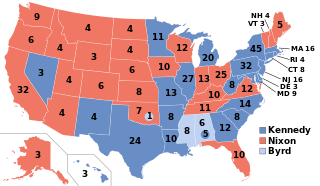
Presidential elections were held in the United States on November 8, 1960. The Democratic ticket of Senator John F. Kennedy and his running mate, Senate Majority Leader Lyndon B. Johnson, narrowly defeated the Republican ticket of incumbent Vice President Richard Nixon and his running mate, U.N. Ambassador Henry Cabot Lodge Jr. This was the first election in which 50 states participated, marking the first participation of Alaska and Hawaii, and the last in which the District of Columbia did not. This made it the only presidential election in which the threshold for victory was 269 electoral votes. It was also the first election in which an incumbent president—in this case, Dwight D. Eisenhower—was ineligible to run for a third term because of the term limits established by the 22nd Amendment.

Presidential elections were held in the United States on November 3, 1964, less than a year following the assassination of John F. Kennedy, who won the previous presidential election. Incumbent Democratic President Lyndon B. Johnson defeated Republican Senator Barry Goldwater in a landslide victory. Johnson was the fourth and most recent vice president to succeed the presidency following the death of his predecessor and win a full term in his own right. Johnson won the largest share of the popular vote for the Democratic Party in history at 61.1%. As of 2024, this remains the highest popular vote percentage of any candidate since the advent of widespread popular elections in 1824.

Presidential elections were held in the United States on November 5, 1968. Republican nominee, former vice president Richard Nixon, defeated both the Democratic nominee, incumbent vice president Hubert Humphrey, and the American Independent Party nominee, former Alabama governor George Wallace.
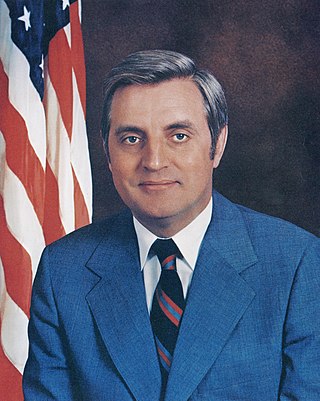
Walter Frederick "Fritz" Mondale was an American lawyer and politician who served as the 42nd vice president of the United States from 1977 to 1981 under President Jimmy Carter. He previously served as a U.S. senator from Minnesota from 1964 to 1976. He was the Democratic Party's nominee in the 1984 presidential election, but lost to incumbent Ronald Reagan in an Electoral College and popular vote landslide.

The 1968 Democratic National Convention was held August 26–29 at the International Amphitheatre in Chicago, Illinois, United States. Earlier that year incumbent President Lyndon B. Johnson had announced he would not seek reelection, thus making the purpose of the convention to select a new presidential nominee for the Democratic Party. Vice President Hubert Humphrey and Senator Edmund Muskie of Maine were nominated for president and vice president, respectively.
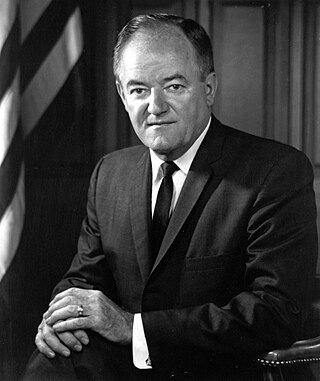
Hubert Horatio Humphrey Jr. was an American politician and statesman who served as the 38th vice president of the United States from 1965 to 1969. He twice served in the United States Senate, representing Minnesota from 1949 to 1964 and again from 1971 to 1978. As a senator he was a major leader of modern liberalism in the United States. As President Lyndon B. Johnson's vice president, he supported the controversial Vietnam War. An intensely divided Democratic Party nominated him in the 1968 presidential election, which he lost to Republican nominee Richard Nixon.
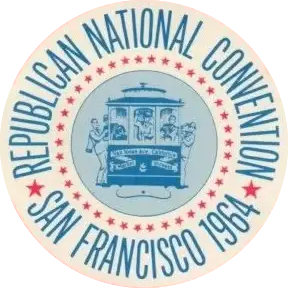
The 1964 Republican National Convention took place in the Cow Palace, Daly City, California, from July 13 to July 16, 1964. Before 1964, there had been only one national Republican convention on the West Coast, the 1956 Republican National Convention, which also took place in the Cow Palace. Many believed that a convention in San Francisco indicated the rising power of the Republican Party in the west.
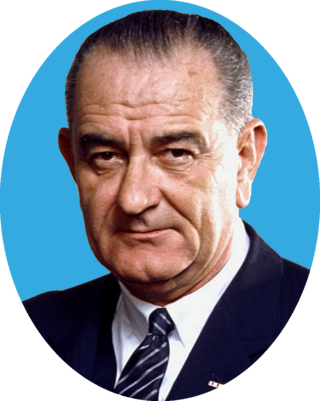
The 1964 Democratic National Convention of the Democratic Party, took place at Boardwalk Hall in Atlantic City, New Jersey, from August 24 to 27, 1964. President Lyndon B. Johnson was nominated for a full term. Senator Hubert H. Humphrey of Minnesota was nominated for vice president. The convention took place less than a year after President John F. Kennedy was assassinated in Dallas, Texas, and Kennedy's legacy was present throughout the convention.

The 1960 Democratic National Convention was held in Los Angeles, California, on July 11–15, 1960. It nominated Senator John F. Kennedy of Massachusetts for president and Senate Majority Leader Lyndon B. Johnson of Texas for vice president.

The 1956 Democratic National Convention nominated former Governor Adlai Stevenson of Illinois for president and Senator Estes Kefauver of Tennessee for vice president. It was held in the International Amphitheatre on the South Side of Chicago from August 13 to August 17, 1956. Unsuccessful candidates for the presidential nomination included Governor W. Averell Harriman of New York, Senator Lyndon B. Johnson of Texas, and Senator Stuart Symington of Missouri.

The 1960 Republican National Convention was held in Chicago, Illinois, from July 25 to July 28, 1960, at the International Amphitheatre. It was the 14th and most recent time overall that Chicago hosted the Republican National Convention, more times than any other city.
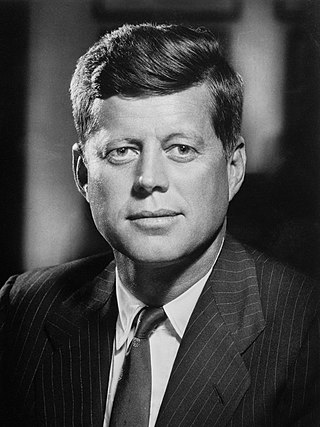
From March 8 to June 7, 1960, voters and members of the Democratic Party elected delegates to the 1960 Democratic National Convention through a series of caucuses, conventions, and primaries, partly for the purpose of nominating a candidate for President of the United States in the 1960 election. The presidential primaries were inconclusive, as several of the leading contenders did not enter them, but U.S. Senator John F. Kennedy of Massachusetts emerged as the strongest candidate and won the nomination over Lyndon B. Johnson at the convention, held from July 11 to 15 at the Los Angeles Memorial Sports Arena.

From March to July 1968, Democratic Party voters elected delegates to the 1968 Democratic National Convention for the purpose of selecting the party's nominee for president in the upcoming election. Delegates, and the nominee they were to support at the convention, were selected through a series of primary elections, caucuses, and state party conventions. This was the last time that state primary elections formed a minority of the selection process, as the McGovern–Fraser Commission, which issued its recommendations in time for the 1972 Democratic Party presidential primaries, would dramatically reform the nomination process to expand the use of popular primaries rather than caucuses.

From March 10 to June 2, 1964, voters of the Democratic Party chose its nominee for president in the 1964 United States presidential election. Incumbent President Lyndon B. Johnson was selected as the nominee through a series of primary elections and caucuses culminating in the 1964 Democratic National Convention held from August 24 to August 27, 1964, in Atlantic City, New Jersey.

The 1964 United States presidential election in Massachusetts took place on November 3, 1964, as part of the 1964 United States presidential election, which was held throughout all 50 states and D.C. Voters chose 14 representatives, or electors to the Electoral College, who voted for president and vice president.
This article lists those who were potential candidates for the Democratic nomination for Vice President of the United States in the 1972 election.
The selection of the Democratic Party's vice presidential candidate for the 1960 United States presidential election occurred at the party's national convention on August 13, 1960. After winning the presidential nomination on the first ballot of the 1960 Democratic National Convention, Massachusetts Senator John F. Kennedy turned his attention to picking a running mate. Kennedy chose Senate Majority Leader Lyndon B. Johnson, who had finished second on the presidential ballot, as his running mate. Johnson, a Protestant Texan, provided geographical and religious balance to a ticket led by a Catholic Northeasterner, but many liberals did not like the pick. Many were surprised both that Kennedy made the offer and that Johnson accepted the offer, as the two had been rivals for the 1960 presidential nomination. According to some accounts, Kennedy had offered the position to Johnson as a courtesy and expected Johnson to decline the offer; when Johnson accepted, Kennedy sent his brother, Robert F. Kennedy, to talk Johnson out of accepting the offer.

The 1964 United States presidential election in Minnesota took place on November 3, 1964, as part of the 1964 United States presidential election. Voters chose ten electors, or representatives to the Electoral College, who voted for president and vice president.
The 1964 presidential campaign of Lyndon B. Johnson was a successful campaign for Johnson and his running mate Hubert Humphrey for their election as president and vice president of the United States. They defeated Republican presidential nominee Barry Goldwater and vice presidential nominee William Miller. Johnson, a Democrat and former vice president under John F. Kennedy was inaugurated as president upon Kennedy's assassination. In 1964, Johnson did not look optimistically upon the prospect of being elected president in his own right. Despite Johnson's uncertainty about running, he was seen as the most likely candidate to get the nomination. He entered the primaries starting with New Hampshire and won the state by almost 29,000 votes. Johnson's main opponent in the primaries was Alabama Governor George Wallace, who had announced his intention to seek the presidency even before Kennedy's assassination.




























